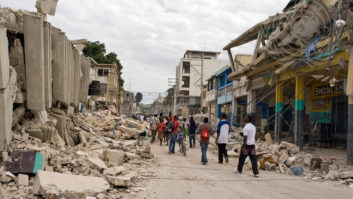As more reports come out of the South Pacific, the death toll from Tuesday’s tsunami continues to rise. Press reports this morning (Oct. 1) indicate that more than 115 people in Samoa, about 30 people in American Samoa and at least nine people in Tonga have been reported dead. Thousands more, particularly in Samoa, have been left homeless or otherwise affected by the tsunami.
In American Samoa, South Seas Broadcasting’s KKHJ-FM is back on air from a backup studio at the transmission site on Mount Olotele. According to a report from KKHJ’s Joey Cummings, relayed via Facebook by South Seas Broadcasting Vice President of Engineering Kick Harnack, as of yesterday (Sept. 30) afternoon Samoa time the station was broadcasting at full power and covering the western half of Tutuila Island.
“Have made patch cord to receive calls on the air. Many touching moments. We are doing good radio. Using computer to play music periodically while we break to gather new info. Team is in full action,” Cummings wrote.
Cummings said he was using a very slow wireless connection for Internet connectivity, thus the brevity and choppy nature of his message.
Cummings continued: “Electricity is the main priority because the east side of the island is completely out whether or not they were hit because the generation plant in the harbor was knocked offline. There will likely be rolling blackouts all over. Search and rescue is priority of other groups. Army, Coast guard is on the island. A planeload of generators is coming tonight.”
Harnack noted that the primary KKHJ studio in Pago Harbor was fine, but without AC power. Backup power in offline, too, as the building generator was under 15 to 20 feet of water for a while when the tsunami came ashore.
John Newton, writing earlier yesterday (Sept. 30) on his blog at PagoPago.com, noted that news sources across American Samoa are having trouble reaching the populace.
“A major group of radio stations is off the air with no indication as to when they will get back. The other is playing music and having meaningless discussions with a member of our Congressman’s office. Our government owned TV is not producing any news and the stations are off the air due to power outage,” he wrote.
President Barack Obama declared the tsunami a national disaster for American Samoa on Sept. 29, making federal funding available for response, recovery and reconstruction efforts.
Concerns about aftershocks and future tsunamis in the region remain high. Tuesday’s quake measured 8.0 on the moment magnitude scale and has been followed by several smaller earthquakes near the same portion of the Kermadec-Tonga Subduction Zone measuring from 5.5 to 5.9 Mw. The most recent aftershock was this morning (Oct. 1) at 06:13 UTC.
Radio New Zealand International reports that following Tuesday’s tsunami warning, telephone communications collapsed in French Polynesia due to the rapid rise in the number of calls, both mobile and fixed, being placed to and from the islands.
“The Tahiti system can handle 100,000 cell phone calls an hour but following the tsunami warning, the equivalent of 300,000 calls was attempted,” RNZI reported.
Although under a tsunami warning, French Polynesia was not hit by substantial waves after Tuesday’s earthquake.
Related —









